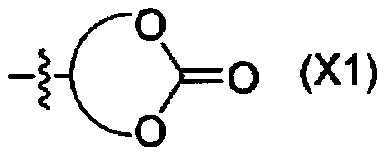Polycarbonate polyol and polyurethane
A polycarbonate and polyol technology, applied in the field of polycarbonate polyol and polyurethane, can solve the problems of insufficient mechanical strength, damage to the chemical resistance and softness of polycarbonate diol, and achieve good reactivity , Excellent stable productivity, and the effect of suppressing gelation problems
- Summary
- Abstract
- Description
- Claims
- Application Information
AI Technical Summary
Problems solved by technology
Method used
Image
Examples
Embodiment
[0332] Hereinafter, although an Example and a comparative example are given and this invention is demonstrated more concretely, unless the summary is exceeded, this invention is not limited to these Examples.
[0333] [Evaluation method]
[0334] The evaluation methods of polycarbonate polyols and polyurethanes obtained in the following examples and comparative examples are as follows.
[0335] [Evaluation of polycarbonate polyol]
[0336]
[0337] Dissolve polycarbonate polyol in CDCl 3 In, measured at 400MHz 1 H-NMR (AL-400 manufactured by JEOL Ltd.) identified phenoxy groups, diols, branched alcohols, and phenols from signal positions of each component, and calculated each content from integral values. The detection limit at this time is 100 ppm by weight of phenol with respect to the weight of the whole sample, and dihydroxy compounds such as the compound represented by the above formula (A) and the compound represented by the above formula (B) are 0.1% by weight. In...
Embodiment I-1
[0373] Put 786.1 g of diethylene glycol (DEG), 744.7 g of triethylene glycol (TEG), and trimethylolpropane into a 5 L glass detachable flask equipped with a stirrer, a distillate trap, and a pressure regulator. (TMP) 25.5 g, diphenyl carbonate (DPC) 2525.0 g, magnesium acetate tetrahydrate aqueous solution 6.3 mL (concentration: 8.4 g / L, magnesium acetate tetrahydrate: 53 mg), and nitrogen replacement was carried out. The internal temperature was raised to 160° C. with stirring, and the contents were heated and dissolved. Then, after reducing the pressure to 24 kPa over 2 minutes, reaction was performed for 90 minutes while removing phenol to the outside of the system. Next, the pressure was lowered to 9.3 kPa over 90 minutes, further lowered to 0.7 kPa over 30 minutes to continue the reaction, and then the temperature was raised to 170° C., while removing phenol and unreacted dihydroxy compound to the outside of the system. Hour reaction, obtain the composition containing po...
Embodiment I-2
[0377] Put 231.8 g of diethylene glycol (DEG), 219.6 g of triethylene glycol (TEG), and trimethylolpropane into a 1 L glass detachable flask equipped with a stirrer, a distillate trap, and a pressure regulator. (TMP) 7.5 g, diphenyl carbonate (DPC) 741.2 g, and magnesium acetate tetrahydrate aqueous solution 1.9 mL (concentration: 8.4 g / L) were replaced with nitrogen. The internal temperature was raised to 160° C. with stirring, and the contents were heated and dissolved. Then, after reducing the pressure to 24 kPa over 2 minutes, reaction was performed for 90 minutes while removing phenol to the outside of the system. Next, the pressure was lowered to 9.3 kPa over 90 minutes, further lowered to 0.7 kPa over 30 minutes to continue the reaction, and then the temperature was raised to 170° C. to remove phenol and unreacted dihydroxy compound to the outside of the system for 15 minutes. hour response. Then, 0.45 mL of an aqueous 0.85% phosphoric acid solution was added to deact...
PUM
| Property | Measurement | Unit |
|---|---|---|
| hydroxyl value | aaaaa | aaaaa |
| breaking strength | aaaaa | aaaaa |
| viscosity | aaaaa | aaaaa |
Abstract
Description
Claims
Application Information
 Login to View More
Login to View More - Generate Ideas
- Intellectual Property
- Life Sciences
- Materials
- Tech Scout
- Unparalleled Data Quality
- Higher Quality Content
- 60% Fewer Hallucinations
Browse by: Latest US Patents, China's latest patents, Technical Efficacy Thesaurus, Application Domain, Technology Topic, Popular Technical Reports.
© 2025 PatSnap. All rights reserved.Legal|Privacy policy|Modern Slavery Act Transparency Statement|Sitemap|About US| Contact US: help@patsnap.com



